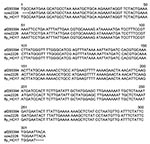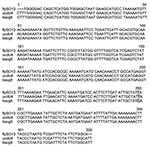Volume 10, Number 7—July 2004
Dispatch
Bartonella spp. DNA Associated with Biting Flies from California
Abstract
Bartonella DNA was investigated in 104 horn flies (Haematobia spp.), 60 stable flies (Stomoxys spp.), 11 deer flies (Chrysops spp.), and 11 horse flies (Tabanus spp.) collected on cattle in California. Partial sequencing indicated B. bovis DNA in the horn fly pool and B. henselae type II DNA in one stable fly.
Bartonella spp. are vector-borne bacteria associated with numerous emerging infections in humans and animals (1). Four Bartonella species have been isolated from wild and domestic ruminants. B. schoenbuchensis and B. capreoli were recovered from wild roe deer (Capreolus capreolus) (2,3) in Europe, whereas B. bovis (formerly B. weissii) was recovered from domestic cattle in the United States and Europe (3–5). Strains similar to B. bovis and B. capreoli were also isolated from mule deer (Odocoileus hemionus) and elk (Cervus elaphus) from California (3,4). Recently, B. chomelii was recovered from bacteremic cows in France (6). A high prevalence of infection with various Bartonella species has been reported in domestic and wild ruminants in North America and Europe (2–4). Of the herds investigated in California, 95% of beef cattle and 17% of dairy cattle were bacteremic for B. bovis and 90% of the mule deer were bacteremic for Bartonella spp (4). The main vector of these ruminant-infecting Bartonella spp. has not been identified.
The role of ticks as potential vectors for Bartonella in cattle was investigated (7,8). In Europe, >70% of 121 Ixodes ricinus ticks collected from roe deer had 16S rRNA gene sequences for Bartonella or other closely related species (7). In California, Bartonella DNA was detected in approximately 19% of 151 questing adult I. pacificus ticks (8), but the direct role of ticks in Bartonella transmission among ruminants has never been established. In a search for an efficient Bartonella vector, which could explain such high prevalence of infection in wild and domestic ruminants, we tested biting flies for Bartonella spp. DNA to establish the potential role of biting flies as vectors of Bartonella in cattle.
Flies were collected by hand, with a bug net, at various locations on the University of California campus, mainly the dairy barn, beef barn, and feedlot, from early July to mid-August 2003. Flies were identified on the basis of morphologic characteristics visually or under binocular lenses for the smaller flies by an experienced entomologist. Of the 370 biting flies collected, 104 (62%) of the horn flies (Haematobia spp.), 60 (33%) of the stable flies (Stomoxys spp.), 11 (92%) of the deer flies (Chrysops spp.), and 10 (91%) of the horse flies (Tabanus spp.) were tested for Bartonella DNA. The stable flies were collected from the dairy and the feedlot barns. The horn flies, deer flies, and horse flies were collected from the beef barn.
Before DNA extraction, the flies were placed in a sterile 1.5-mL microtube, washed with 70% ethanol, and rinsed with sterile water. Because of size differences among the flies, 2–3 horn flies were grouped together in a single microtube, while each stable fly was placed in an individual vial. The abdomen of deer flies and horse flies was first removed and then placed in individual vials. DNA extraction was performed by using the DNeasy Tissue Kit (Qiagen, Valencia, CA) according to the manufacturer’s instructions, with some minor adjustments. The amount of reagents for the deer and horse flies were doubled, and the flies were incubated in a waterbath overnight at 55°C.
Bartonella DNA was detected by polymerase chain reaction (PCR) using primers for the citrate synthase (gltA) gene, as previously published (9). Undiluted DNA extracted from the flies was used as the DNA template. As a positive control, a low concentration of B. henselae was added to a separate set of the same DNA template. A negative control was made by using sterile water instead of the DNA template. Using gel electrophoresis, we analyzed PCR products for the appearance of an ≈380-bp fragment. Any evidence of a 380-bp fragment was further analyzed by restriction fragment length polymorphism (RFLP) procedures, by using TaqI (Promega Corp., Madison, WI), HhaI, AciI, and MseI endonucleases (New England Biolabs, Beverly, MA), and DNA sequence analysis (Davis Sequencing, Davis, CA).
Four of the 60 stable flies and one pool (2 flies) of the 45 horn fly pools showed a 380-bp fragment. PCR/RFLP analysis confirmed Bartonella DNA in one of the four stable flies and in the horn fly pool. However, for the three other stable flies, the PCR/RFLP profiles did not match any known Bartonella digestion profile. The sequence obtained from the horn fly pool (Haematobia spp.) collected in the beef cattle barn was identical to that for B. bovis (Figure 1). The sequence obtained from a stable fly (Stomoxys spp.) collected in the dairy cattle barn was identical to that for B. henselae type M (Marseille) (Figure 2). The highlighted area indicates the divergence between B. henselae type H (Houston I) and B. henselae type M, as previously described (10).
This identification of Bartonella DNA is the first associated with horn and stable flies and the first identification of B. henselae from a biting fly. It is also the first report of identification of Bartonella DNA from flies from North America. This finding demonstrates, as for ticks, that Bartonella DNA is present in various biting insects. We found a very low percentage of Bartonella DNA–positive flies, in contrast to the very high prevalence (57 [88%] of 65 observed in Hippoboscidae adult flies Lipoptena cervi and Hippobosca equina) collected from domestic cattle and wild roe deer in France (H.J. Boulouis, pers. comm.). This low prevalence may be related to the fact that different fly species were tested but more likely could be associated with a low level of Bartonella bacteremia in our herds. In a previous study, only 17% of cows in a dairy herd were bacteremic (4), and prevalence was even lower in another dairy herd from Tulare, in the central valley of California (B.B. Chomel et al., unpub. data). A follow-up for this study would be to collect blood from herds at the University of California, Davis, and establish the status of Bartonella bacteremia. Future research should include collecting flies in different locations and herds in which high levels of bacteremia were previously detected. Inhibitory factors were unlikely to be associated with such a low prevalence because spiked controls were systematically detected.
Identification of B. henselae DNA in a stable fly indicates the wide range of blood-sucking arthropods that can harbor this human pathogen. The partial gltA sequence was identical to that for B. henselae type Marseille, the most common type found in cats and humans in California (11). Fleas have been shown to be an efficient vector of B. henselae (12–14). More recently, B. henselae DNA was identified in adult questing I. pacificus ticks from California and from I. ricinus ticks collected on humans in Italy (8,15). The role of ticks as potential vectors of B. henselae in humans has also been suggested (16–18). Since bartonella are likely to be present in biting flies, investigating the potential of biting flies as either mechanical or biologic vectors of Bartonella in cattle and possibly humans should be pursued.
Ms. Chung’s summer fellowship was funded by the Center for Comparative Medicine, University of California, Davis, through a training grant from the National Institutes of Health.
Ms. Chung is a second-year student at the School of Veterinary Medicine, University of California, Davis. This study was performed as her NIH summer fellowship through the Center for Comparative Medicine at University of California, Davis.
Acknowledgment
We thank Robin Houston for helping identify flies.
References
- Breitschwerdt EB, Kordick DL. Bartonella infection in animals: carriership, reservoir potential, pathogenicity, and zoonotic potential for human infection. Clin Microbiol Rev. 2000;13:428–38. DOIPubMedGoogle Scholar
- Dehio C, Lanz C, Pohl R, Behrens P, Bermond D, Piemont Y, Bartonella schoenbuchii sp. nov., isolated from the blood of wild roe deer. Int J Syst Evol Microbiol. 2001;51:1557–65.PubMedGoogle Scholar
- Bermond D, Boulouis HJ, Heller R, Van Laere G, Monteil H, Chomel BB, Bartonella bovis Bermond et al. sp. nov. and Bartonella capreoli sp. nov., isolated from European ruminants. Int J Syst Evol Microbiol. 2002;52:383–90.PubMedGoogle Scholar
- Chang CC, Chomel BB, Kasten RW, Heller RM, Ueno H, Yamamoto K, Bartonella spp. isolated from wild and domestic ruminants in North America. Emerg Infect Dis. 2000;6:306–11. DOIPubMedGoogle Scholar
- Breitschwerdt EB, Sontakke S, Cannedy A, Hancock SI, Bradley JM. Infection with Bartonella weissii and detection of Nanobacterium antigens in a North Carolina beef herd. J Clin Microbiol. 2001;39:879–82. DOIPubMedGoogle Scholar
- Maillard R, Riegel P, Barrat F, Bouillin C, Thibault D, Gandoin C, Bartonella chomelii sp. nov., isolated from French domestic cattle (Bos Taurus). Int J Syst Evol Microbiol. 2004;54:215–20. DOIPubMedGoogle Scholar
- Schouls L, Van de Pol I, Rijpkema SGT, Schot CS. Detection and identification of Erlichia, Borrelia burgdorferi sensu lato, and Bartonella species in Dutch Ixodes ricinus ticks. J Clin Microbiol. 1999;37:2215–22.PubMedGoogle Scholar
- Chang CC, Chomel BB, Kasten RW, Romano V, Tietze N. Molecular evidence of Bartonella spp. in questing adult Ixodes pacificus ticks in California. J Clin Microbiol. 2001;39:1221–6. DOIPubMedGoogle Scholar
- Norman AF, Regnery R, Jameson P, Greene C, Krause DC. Differentiation of Bartonella-like isolates at the species level by PCR–restriction fragment length polymorphism in the citrate synthase gene. J Clin Microbiol. 1995;33:1797–803.PubMedGoogle Scholar
- Dillon B, Valenzuela J, Don R, Blanckenberg D, Wigney DI, Malik R, Limited diversity among human isolates of Bartonella henselae. J Clin Microbiol. 2002;40:4691–9. DOIPubMedGoogle Scholar
- Chang CC, Chomel BB, Kasten RW, Tappero JW, Sanchez MA, Koehler JE. Molecular epidemiology of Bartonella henselae infection in human immunodeficiency virus–infected patients and their cat contacts, using pulsed-field gel electrophoresis and genotyping. J Infect Dis. 2002;186:1733–9. DOIPubMedGoogle Scholar
- Koehler JE, Glaser CA, Tappero JW. Rochalimaea henselae infection. A new zoonosis with the domestic cat as reservoir. JAMA. 1994;271:531–5. DOIPubMedGoogle Scholar
- Chomel BB, Kasten RW, Floyd-Hawkins K, Chi B, Yamamoto K, Roberts-Wilson J, Experimental transmission of Bartonella henselae by the cat flea. J Clin Microbiol. 1996;34:1952–6.PubMedGoogle Scholar
- Foil L, Andress E, Freeland RL, Roy AF, Rutledge R, Triche PC, Experimental infection of domestic cats with Bartonella henselae by inoculation of Ctenocephalides felis (Siphonaptera: Pulicidae) feces. J Med Entomol. 1998;35:625–8.PubMedGoogle Scholar
- Sanogo YO, Zeaiter Z, Caruso G, Merola F, Shpynov S, Brouqui P, Bartonella henselae in Ixodes ricinus ticks (Acari: Ixodida) removed from humans, Belluno province, Italy. Emerg Infect Dis. 2003;9:329–32.PubMedGoogle Scholar
- Lucey D, Dolan MJ, Moss CW, Garcia M, Hollis DG, Wegner S, Relapsing illness due to Rochalimaea henselae in immunocompetent hosts: implication for therapy and new epidemiological associations. Clin Infect Dis. 1992;14:683–8.PubMedGoogle Scholar
- Zangwill KM, Hamilton DH, Perkins BA, Regnery RL, Plikaytis BD, Hadler JL, Cat scratch disease in Connecticut. Epidemiology, risk factors, and evaluation of a new diagnostic test. N Engl J Med. 1993;329:8–13. DOIPubMedGoogle Scholar
- Eskow E, Rao RV, Mordechai E. Concurrent infection of the central nervous system by Borrelia burgdorferi and Bartonella henselae: evidence for a novel tick-borne disease complex. Arch Neurol. 2001;58:1357–63. DOIPubMedGoogle Scholar
Figures
Cite This ArticleTable of Contents – Volume 10, Number 7—July 2004
| EID Search Options |
|---|
|
|
|
|
|
|


Please use the form below to submit correspondence to the authors or contact them at the following address:
Bruno B. Chomel, Department of Population Health and Reproduction, School of Veterinary Medicine, University of California, Davis, CA 95616, USA; fax: 530-752-2377
Top